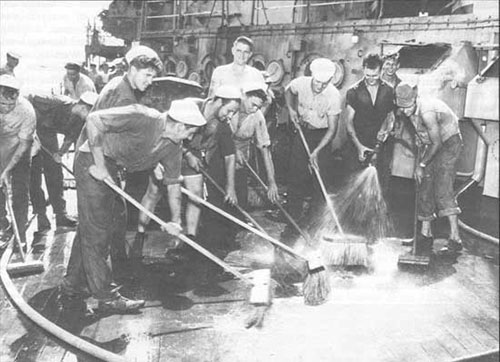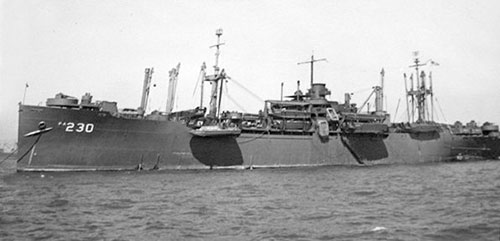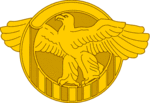FUBAR

(Deck Department conducting decontamination drill on one of the support ships after the BAKER Test at Bikini Atoll. Photo USN).
There is a corollary to the term “SNAFU.” It is “FUBAR,” which is usually the end-state of a SNAFU that goes beyond the normal regime. That was precisely the situation in the lagoon at Bikini after the BAKER blast.
Sailors sent aboard the target ships were exposed to radiation as they tried to decontaminate them. They in turn brought radiation back to the support fleet, and through it all, we were taking seawater in from the lagoon to distill and use for cooking, coffee, laundry and showers.
All the pigs and most of the rats on the test ships died, though it was several days before sailors were able to re-board the target ships where test animals were located; during that time the accumulated doses from the gamma rays produced by fission products became lethal for the animals. The reporters and correspondents were gone by that time. Much of the public interest in Operation Crossroads had focused on the fate of the test animals, so by September Vice Admiral Blandy issued a press release stating that the tests had demonstrated that radiation death is not painful. “The animal merely languishes and recovers or dies a painless death.” He said. “Suffering among the animals as a whole was negligible.”
I was dubious about that. The scientist from Los Alamos I had befriended on Nagato had been graphic about the suffering of his two associates who had been killed by exposure to the Demon Core, but that was not a matter of public knowledge. Privately, the consensus was that if the target ships had been fully manned at the time of the tests, there would have been 35,000 casualties.
After the August 10 decision to stop decontamination work at Bikini, the surviving target fleet was towed to Kwajalein Atoll where the live ammunition and fuel could be offloaded in uncontaminated water, thereby contaminating it. That was a more normal sort of SNAFU than what had happened in the aftermath of the BAKER shot. Most of the personnel were embarked in support ships, and transported back to CONUS. By September, only a residual force of some working parties was left to try to clean up the facilities ashore.
Nagato and Sakawa were at the bottom of the lagoon and were going to stay there. Eight of the major ships and two submarines were towed back to the United States and Hawaii for radiological inspection. Twelve target ships were so lightly contaminated that they were re-manned and sailed back to the United States by their original crews. The support ships were decontaminated as necessary and received a radiological clearance before they could return to the Fleet. We could have told them the answer about decontamination efforts- they don’t work.
The hulls of the support ships that entered the lagoon after BAKER became so radioactive that sleeping quarters were moved toward the center of each ship. All the support ships that returned to the lagoon were to some degree radiologically suspect depending on how long they spent near ground zero and how much water from the lagoon they had processed through their pipes and tanks.

I was assigned to get a ride home on the USS Rockwall (APA-230), a Haskell-class attack transport. As we made preparations to get underway for the TRANSPAC, I saw what the working parties were asked to do. Some sailors swabbed the decks, while others were lowered to the water in dinghiess, given short-handled hoes and told to start scraping. As the gentle waves jostled the ships, the men would be thrown against the hill, encrusted with the green algae slime and barnacles, painting their sweating torsos with the contaminated organic material.
A couple members of Rockwall’s deck department lost their hair, and sported bald pates until a new crop of hair grew in.
Accommodations were Spartan, but at the end of it was San Francisco, and home. I passed the time making some rough notes about what I had seen in Japan and the technical characteristics of Japanese naval architecture and ship design. When we got back to San Francisco, some of the CROSSROADS ships were directed to fly the yellow pennant signifying “quarantine” until shore authorities were satisfied they were no threat. As a practical matter, that meant cleaning surfaces and flushing systems with caustic solutions, dismantling the water intakes and boiler operating systems. Hundreds of rags were used, and then discarded overboard.
As an officer, I did not have to take part in that, but I was happy to grab my seabag and disembark in Oakland, and take the train back across the country to Washington to make a final report to the Technical Assessment Team- Japan before I could be demobilized the following January and return to civilian life.
As part of out-processing at the Washington Navy Yard, I was cautioned that the events I had experienced at Bikini were considered restricted data, and that I should not talk about it. The return to civilian life was preceded by a cursory physical examination. Then I was thanked for my service, and handed the coveted Ruptured Duck pin for my lapel, signifying my honorable discharge from the Navy.

I am only telling you this because I am not sure that anyone else is going to be around to tell the story of the last cruise of the battleship Nagato.
I have had a series of skin problems over the years, possibly because I have spent a lot of time in the sun while diving, and some other nagging problems. But I just received a diagnosis saying I have something called “multiple myeloma.”
The prognosis is not good, they tell me. This account is something I have been meaning to get to for several years, and it is as good as I can give at this remove from the events. I also need to find a home for the vacuum tubes and condenser I removed from the battleship as well. They are historic, and were part of the radio that announced the Japanese attack to Admiral Yamamoto on Pearl Harbor thirty-six years ago this month.
Someone may be interested someday.
Edward Smith Gilfillen
Saratoga, New York
December, 1977
Copyright 2015 Vic Socotra
www.vicsocotra.com
Twitter: @jayare303
